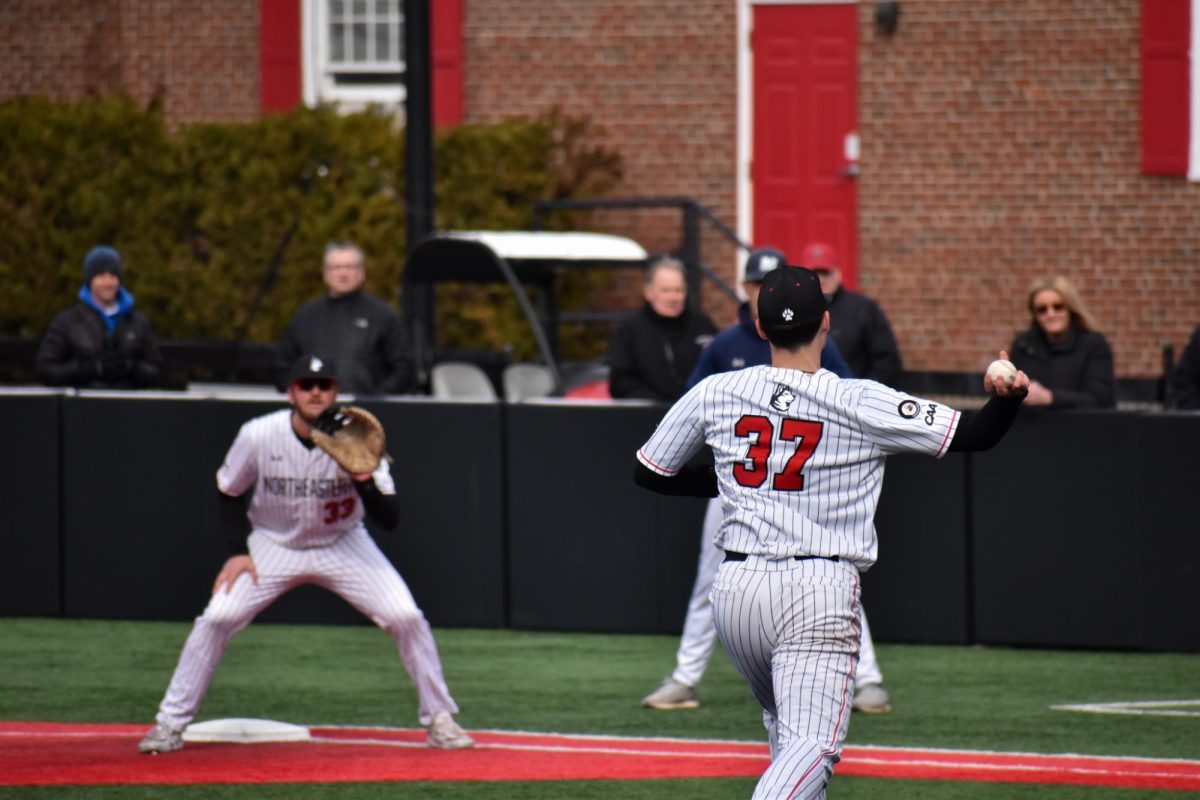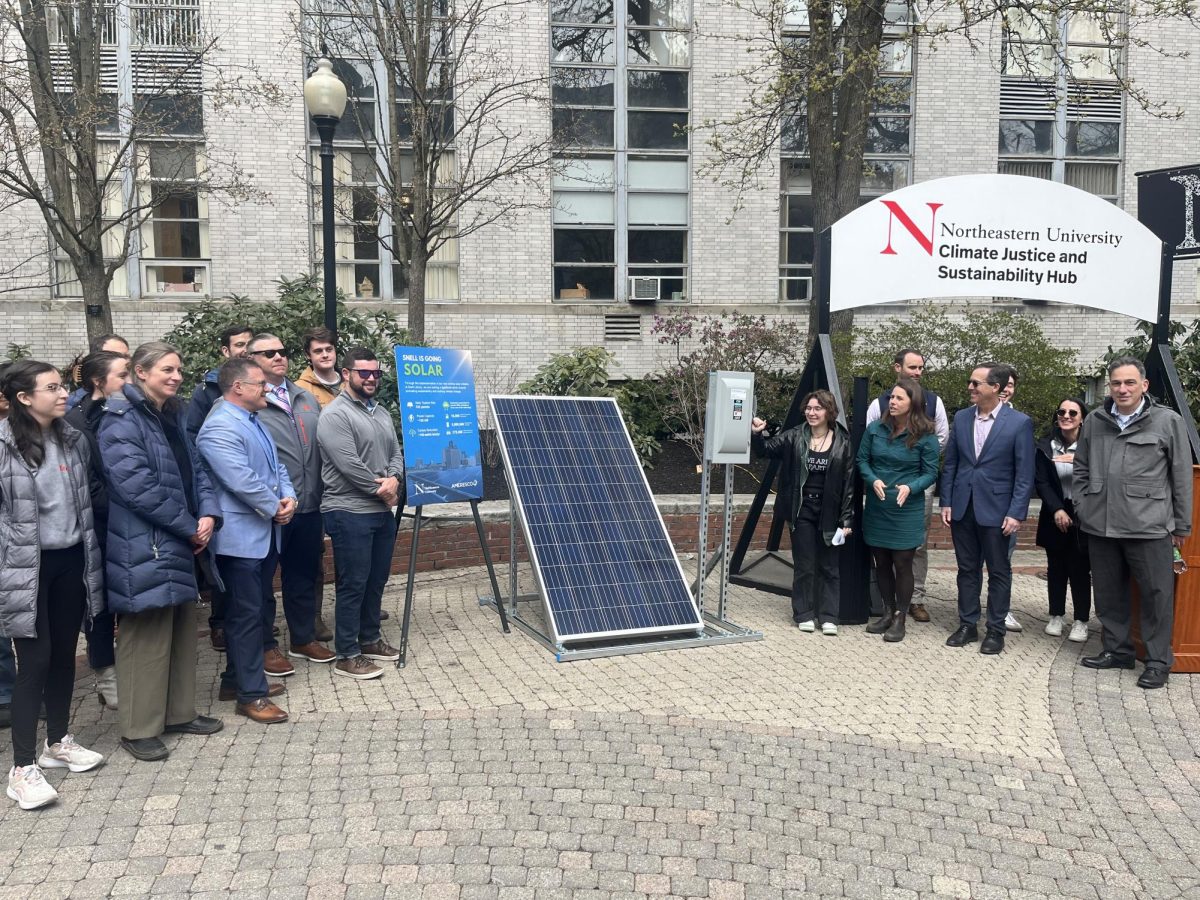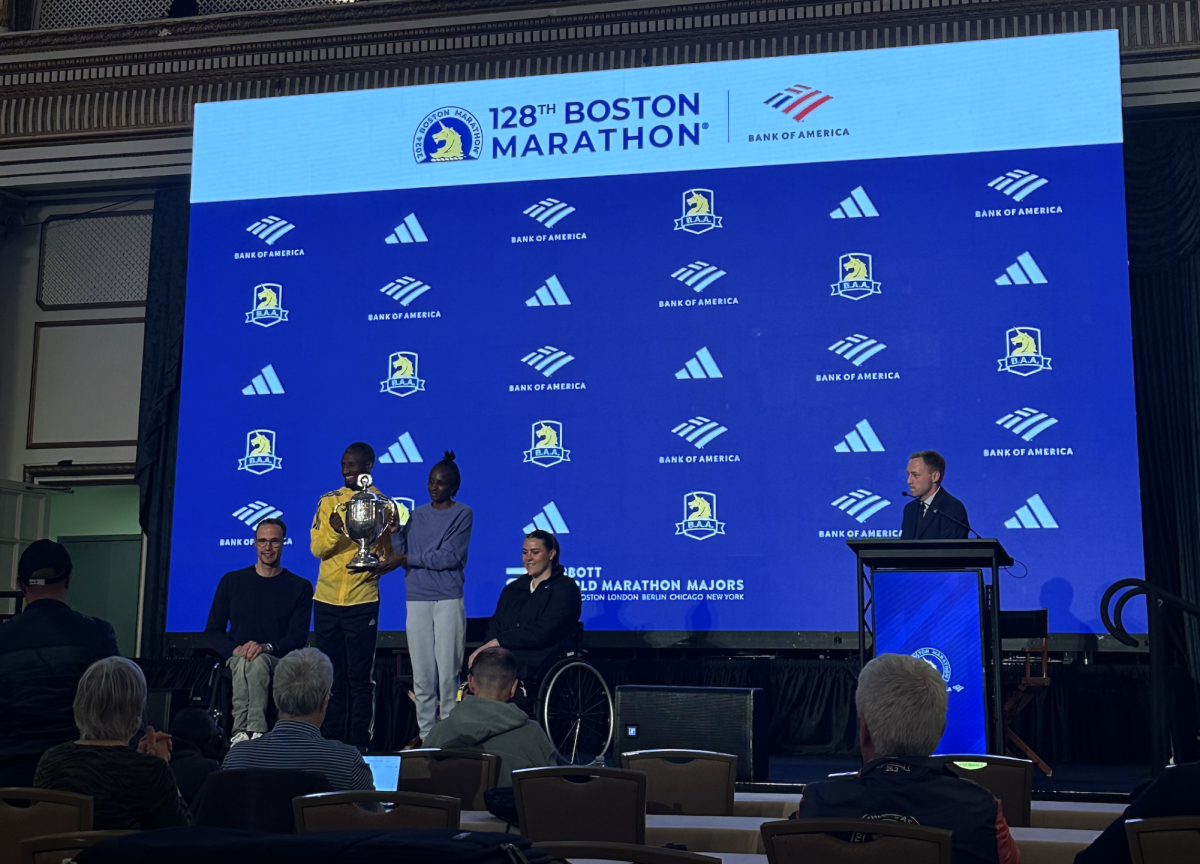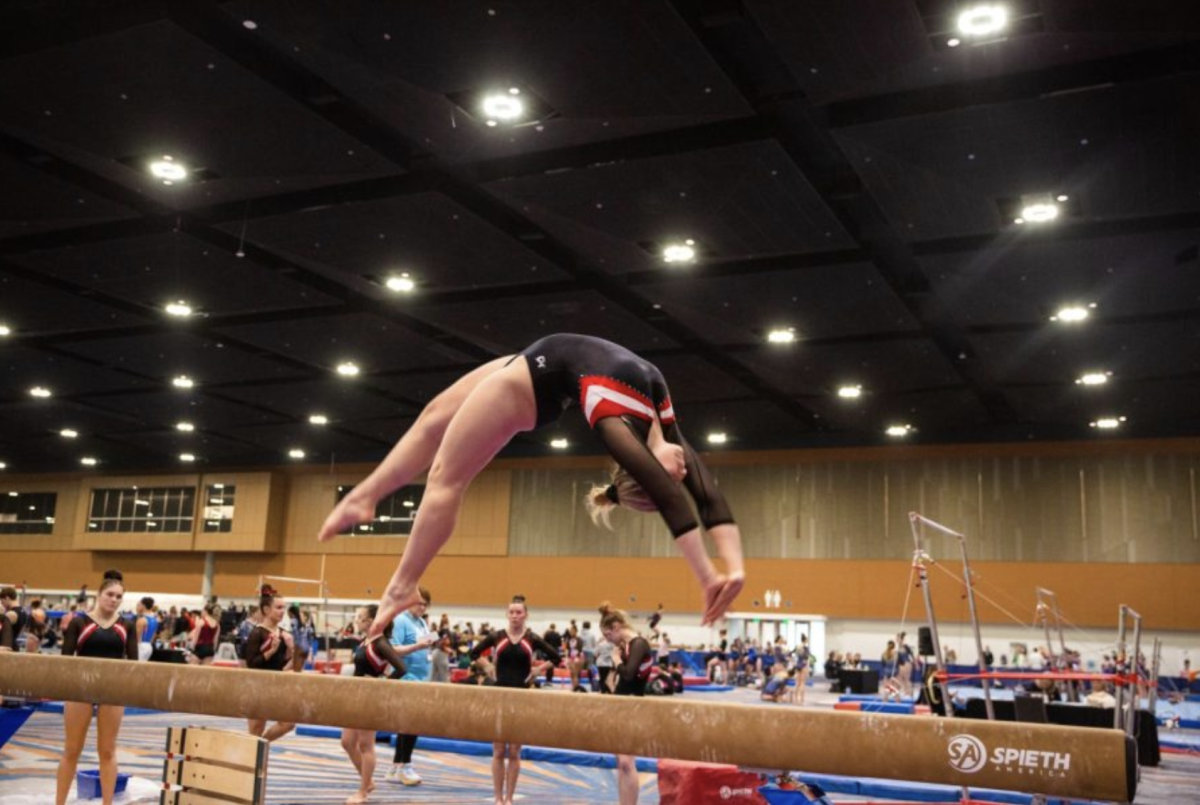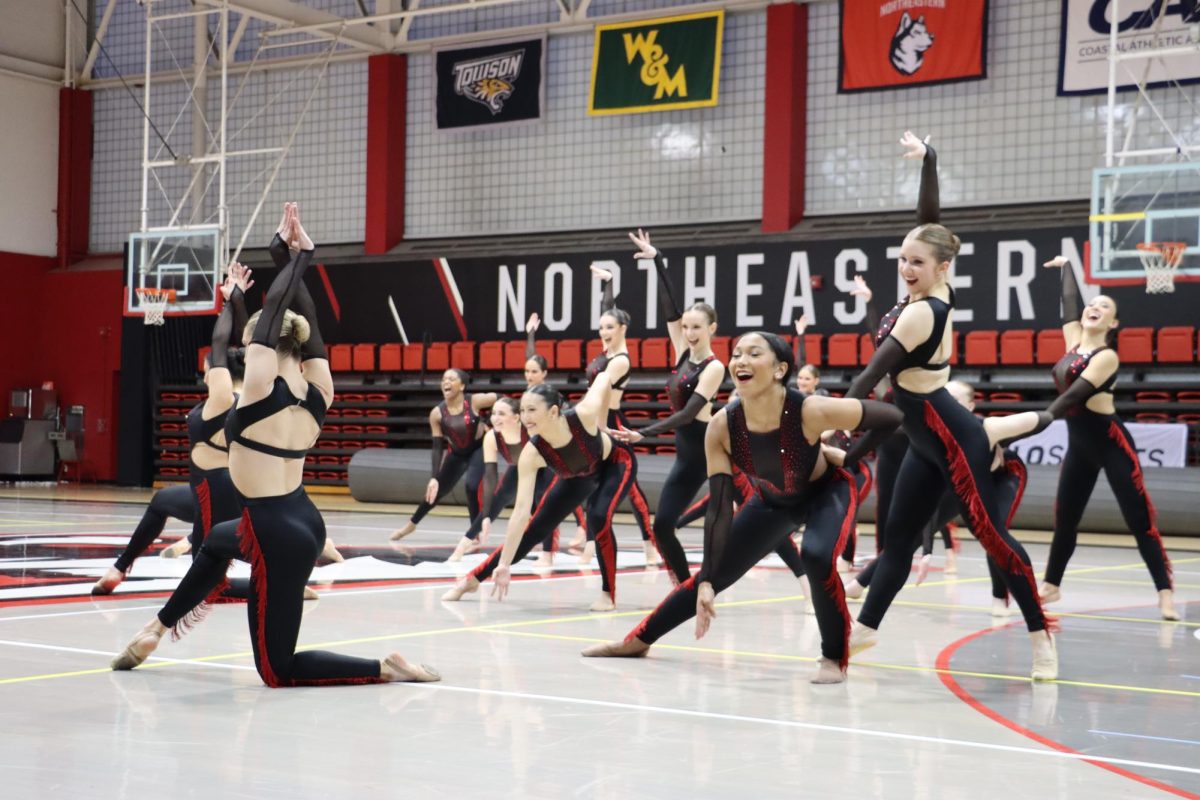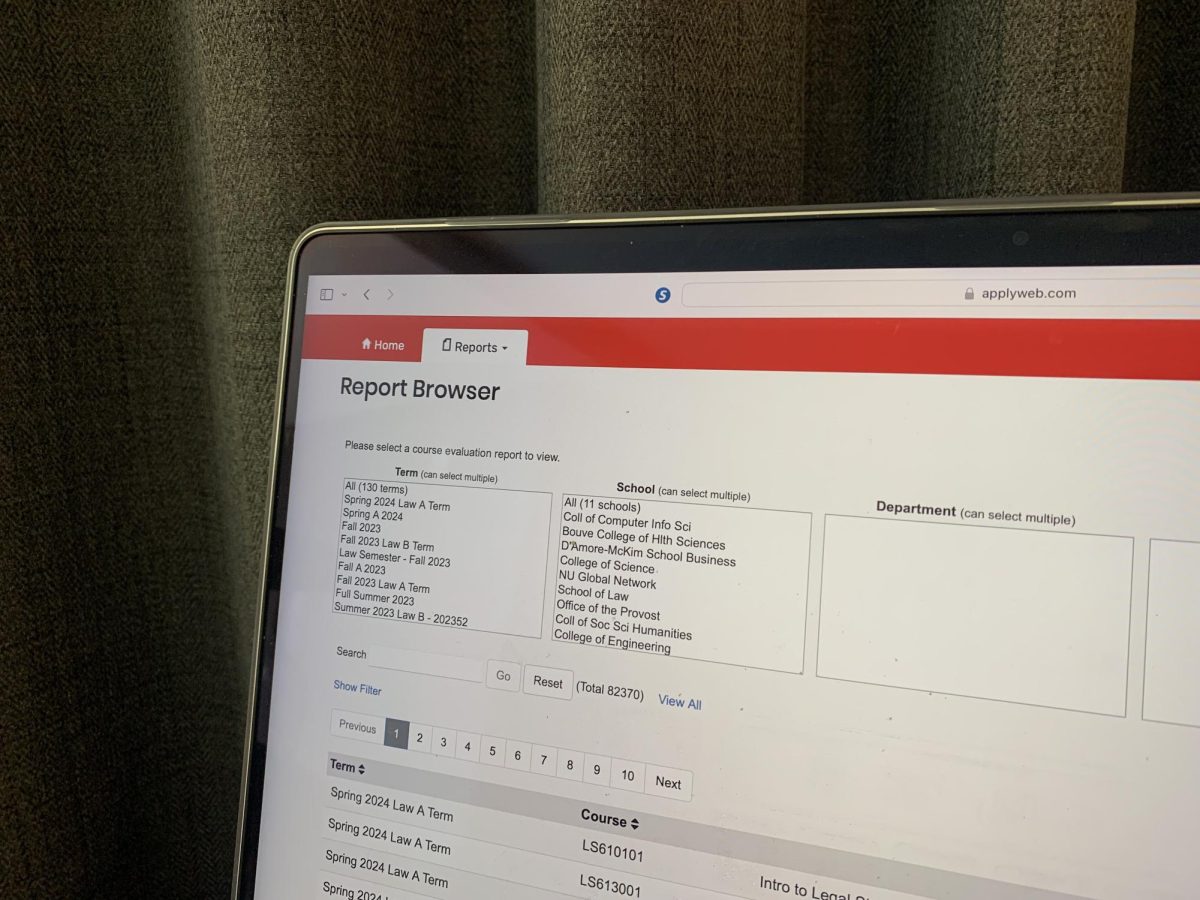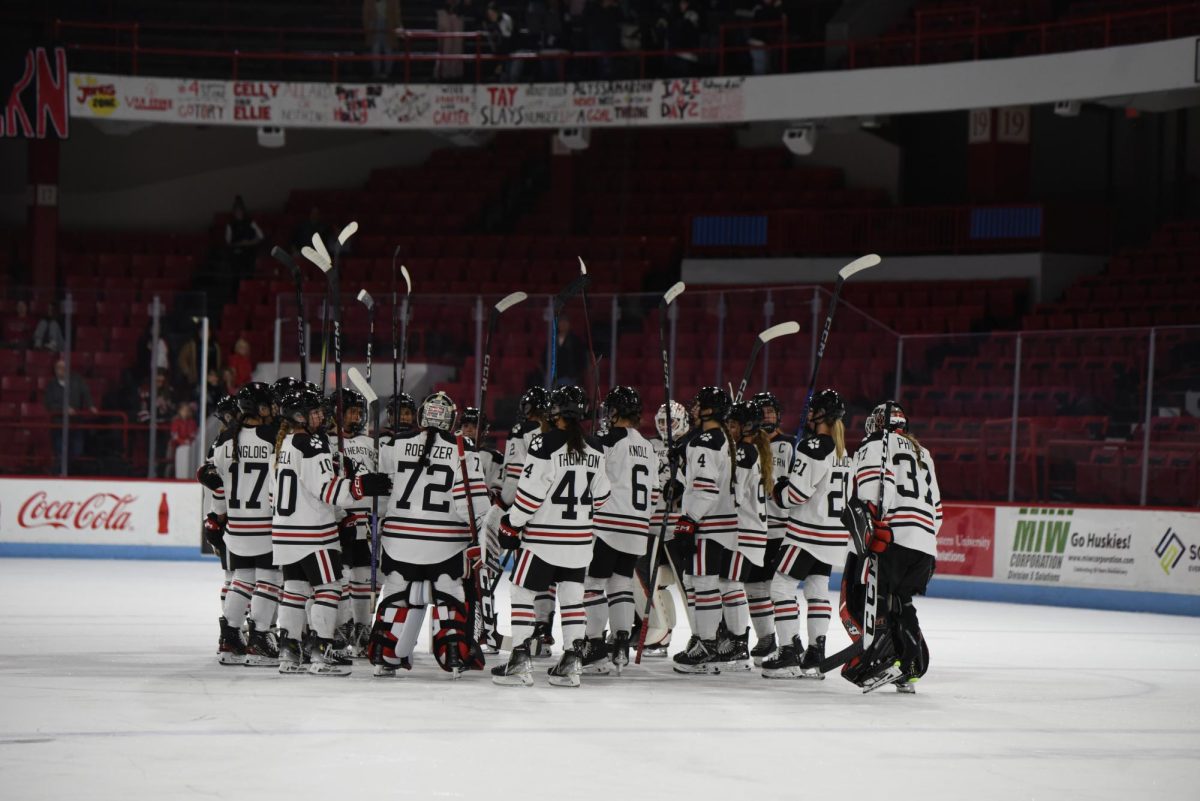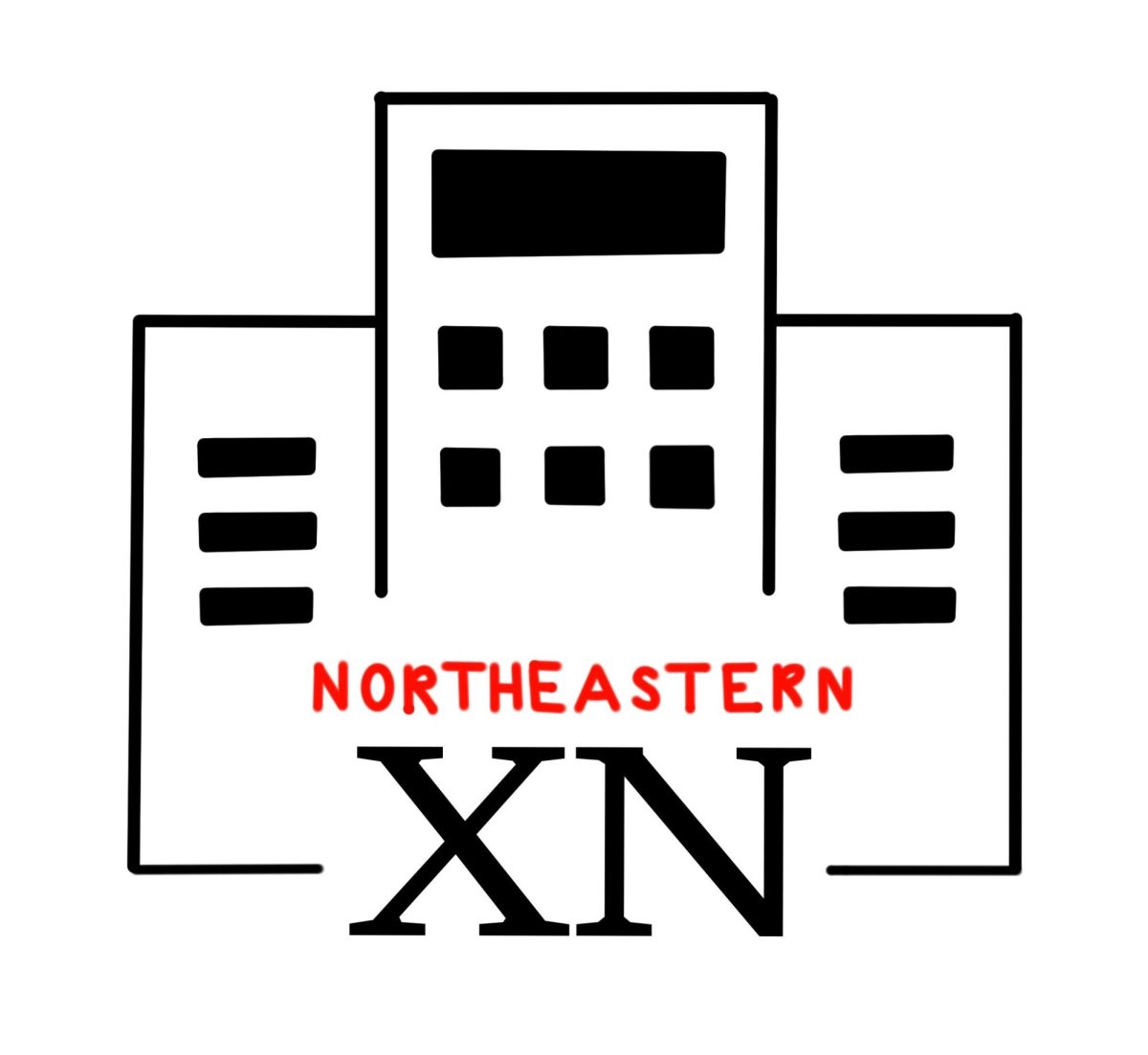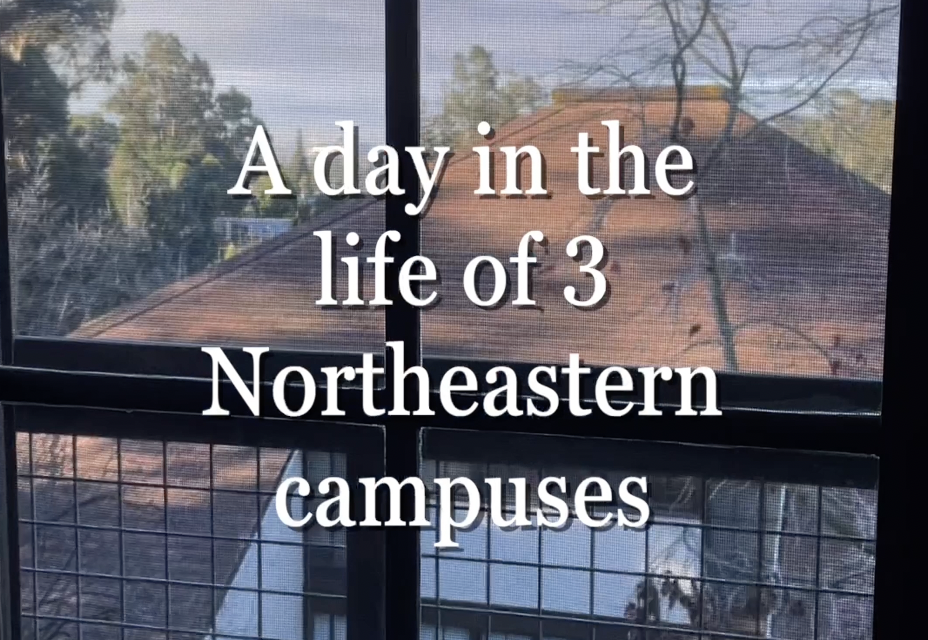By Gordon Weigers, news staff
As the game clock stood still with 2.6 seconds remaining in the third period of the Hockey East Championship game at TD Garden, the Northeastern Huskies and University of Massachusetts-Lowell River Hawks lined up for the game’s final faceoff in front of Northeastern goalie Ryan Ruck.
Lowell defenseman Tommy Panico took a final shot, but Husky sophomore Nolan Stevens dove in front of the puck to keep it away from the net as the clock struck zero. The Huskies threw their helmets and gloves into the air and mobbed their victorious goaltender, becoming the first Northeastern team to win the Hockey East title since 1988.
A mass of students wearing the red and black of Northeastern spanned seven sections of the upper seats of TD Garden and experienced emotions that no student, professor or alumnus of Northeastern had felt in 28 years. The energy flowed from the students to the fans who chose to stay away, from the raucous undergraduates to the victorious players on the ice as the 2016 Hockey East Champion Northeastern University banner was raised to the rafters.
This is what college sports is meant to be: Current students, alumni, teachers and staff of proud institutions coming out to support their school’s athletic teams and showing their spirit for their college or university. While this was the scene at TD Garden on March 19, this is not the norm for Northeastern.
“When there’s something on the line, the fan base comes out in droves,” said Michael Davis, a senior health science major and diehard Northeastern sports fan.
As the leader of the NU Doghouse, the student fan section at the Northeastern men’s hockey games, Davis has seen crowds of all sizes at games. Unfortunately, he sees smaller crowds more often than large ones.
“We know big crowds can happen, but it’s upsetting when they don’t happen with more regularity,” Davis said.
Northeastern has become an increasingly popular university for its famous co-op program as well as its valuable academic ranking. Even with the emphasis on academics, NU has flown under the radar in the college sports world, despite collecting some very impressive accolades in recent years. In 2015, the men’s basketball team won the Colonial Athletic Association championship, giving them an automatic berth into the NCAA tournament, where they fell four points short of upsetting heavily favored Notre Dame.
During the 2015-16 hockey season, the men’s hockey team overcame an abysmal start to win 20 of their final 24 games en route to the Hockey East title and an NCAA tournament appearance. The Northeastern women’s hockey team had a year for the record books, winning a program-best 28 games to reach the NCAA tourney for the first time in school history. Senior forward Kendall Coyne broke the school records for most goals and most points all-time and earned the Patty Kazmaier Award as the most valuable player in women’s college hockey.
However, for third-year business major Sami Berrada, sports at Northeastern take a backseat to academics and co-op.
“The workload at Northeastern really prevents me from getting to more games,” he said.
For Berrada and countless other students, going to games can be fun, but they’re at Northeastern for the degree that they will leave with, not for mildly competitive college sports.
“Sports enhance the experience, but they’re not necessary for me,” Berrada said.
Sometimes, winning can be everything
The Boston sports scene has historically been dominated by professional teams rather than college teams. The Red Sox, Celtics, Bruins and Patriots are the four major sports teams that call the city home. They command more attention than the multitude of college level teams in the area, regardless of the success of those college teams.
As Davis prepares to graduate from Northeastern this May, he has been reflecting on his experiences at sporting events on campus. He has pinpointed one thing that Northeastern teams could improve upon to draw more fans to games.
“Winning isn’t everything, but it helps a lot,” Davis said.
Dan Shaughnessy, a sports writer at the Boston Globe for the last 35 years, would likely disagree with Davis. He’s seen enough winning teams at the college level in Boston during his time covering sports in the city to know that a successful college team is still not as popular as a professional team. In 2007, Boston College (BC) had the No. 2 football team in the country and boasted an 11-3 record at the end of the season. As any Boston sports fan can attest to, 2007 was a wildly important year for the sports landscape in Boston, and it was not because of BC’s football team. The Red Sox had just won their second world series in four years, the Celtics were on their way to their first NBA championship in 21 years and the Patriots carried an undefeated record into the Super Bowl.
“BC was not even on the map as the No. 2 team in the country,” Shaughnessy said. “It’s just not a mainstream thing.”
One noticeable absence from the Northeastern sports community is the presence of a football team. A major part of many large universities, football programs can dominate the sports culture of not just the school, but the entire surrounding town as well. From 1933 to 2009, Northeastern had a Division I football team that produced five NFLers and 20 All-Americans and won the Atlantic 10 championship in 2002. Eight years removed from the last season of Husky football, few people at the school are bothered by the lack of one of the nation’s most popular college sports.
Though having a football team works at schools like Penn State or Ohio State, it was simply not sustainable at Northeastern. Playing their games at Parsons Field in Brookline, a 30-minute walk from campus, the Huskies were not able to generate the same kind of buzz as other renowned football programs. Davis agreed that trying to bring back the football team at Northeastern would be a mistake and that sinking money into a team that was consistently subpar would be a waste.
“It’s not about having a football team,” Davis said. “It’s about having a good football team.”
Not just a Northeastern issue
Being one of the 13 cities nationwide that represents all four of the major sports, Boston has a unique passion for athletics that isn’t found anywhere else in the country. The 17-time NBA champion Boston Celtics have instilled a love for basketball in the city that, according to Shaughnessy, hasn’t exactly translated to the college level. He knows from experience that college teams in Boston don’t have the same following as the Celtics.
“I used to get letters from [former NU men’s basketball coach] Jim Calhoun and [former BU men’s basketball coach] Rick Pitino asking me to come and cover their games,” Shaughnessy said.
In 2010, Northeastern made renovations to Matthews Arena to optimize the facility for hosting both hockey and basketball. Already known as a cathedral for hockey games, the renovation plan was successful in improving the atmosphere for basketball games as well.
The “N” Zone, the student section dedicated to the men’s basketball team, surrounds half of the court during games and allows the fans to be closer to the action than ever before. From loud cheers to body paint and bizarre signs designed to distract the visiting team, the “N” Zone creates a rowdy scene at home games and has a core group that is loyal to the team, whether they are winning or losing.
“One of the things that I thought was important was to get the students courtside,” said Bill Coen, head coach of the Northeastern men’s basketball team. “It creates a culture and an atmosphere to give our students an identity in the game.”
While there is a core group of “N” Zone members, the majority of the attendees that occupy the student section are there to experience what a Northeastern basketball game is like, even if they don’t love basketball.
Students who are not major sports fans have a hard time enjoying games and are more likely to go out and capitalize on the myriad of other things to do in Boston. Coen has found this trend holds true beyond the NU campus.
“It’s not something that’s just a Northeastern phenomenon,” he said. “If you go over to Boston College or Harvard or [Boston University], it’s just a byproduct of living in a very vibrant city with a lot happening and a lot of options.”
During the 2015-16 season, the NU basketball team averaged an attendance of 1,786 for home games, while Matthews Arena has a capacity for basketball of 5,066. They only reached capacity once, when 5,288 people packed the historic old barn as the Huskies played the top ranked team in the nation, the Michigan State Spartans. The next game after hosting Michigan State, only 923 people showed up to watch Northeastern take on the University of Vermont.
At Boston College (BC) this year, a similar trend unfolded. Conte Forum, the home of the BC men’s basketball team, has a capacity of 8,606 for basketball, yet an average of only 3,411 people came to their games. The Eagles, who drew only 1,018 spectators against Virginia Tech on Feb. 23, soldout against Syracuse on Feb. 14 and had a crowd of 7,963 on hand to watch BC take on Duke on Jan. 2.
“Boston is an event town and [the Michigan State game] was certainly the event in college basketball in this city,” Coen said. “Hosting the number one team in the country, hosting the hall of fame coach [Tom Izzo], having it in historic Matthews Arena, all those elements just came together and collided into a once-in-a-lifetime event.”
The game against Michigan State was truly a once-in-a-lifetime event for Northeastern because it is unlikely that they will have the same buzz around the team again in the near future. That has nothing to do with how hard the team works or the character of the players; it’s just that the country is only interested in the best teams, and if you’re not playing them often, people are unlikely to care.
The future of the fairweather fan
Northeastern has joined the conversation of the best institutions in the US, but is still on the outside looking in at athletics. Students that come to NU today are more career oriented than ever before, and find that athletics are a supplementary part of the Northeastern experience.
Colleges and universities that are famous for their successful athletic programs draw students that are more focused on the college experience than what comes after. Shaughnessy has seen a trend among students who just want to be part of a school whose athletic teams already have a huge following.
“Kids will go to Syracuse or Villanova to be a part of that even if they stink,” he said.
There was an outpouring of support on campus for the Northeastern men’s basketball team in 2015, as hundreds of fans came out to see the team off before they left for the national tournament. Berrada said that supporting the team was much easier last year when they were winning important games and giving the fans something to cheer for.
“Besides BU and BC, we don’t play any high level teams that would encourage me to go to games,” Berrada said. “When we’re not playing anyone good and we’re still losing, I won’t go.”
For the last nine years, executive professor of accounting Charlie Bame-Aldred has been the volunteer public address announcer at games for every sport on campus from men’s hockey to women’s volleyball. His enthusiasm and passion for Northeastern sports is evident in his roars over the loudspeaker when the Huskies score a goal on the ice or win a big point on the volleyball court.
“I don’t care if there’s one person in the stands or thousands of people,” Bame-Aldred said. “I’m there to help the student-athletes have a better experience.”
After all, showing school spirit is all about the student-athletes that are out there playing in these games, whether people show up or not. For freshman hockey player Adam Gaudette, the support from people like Bame-Aldred, Davis and anyone who shows up to Matthews Arena for a game can really drive the team to success.
“Once we got through our tough start, the Doghouse was still there supporting us the rest of the way,” Gaudette said. “It goes to show that our fans are the best fans in college hockey.”
Now that both hockey teams on campus are trending up, support has been increasing. The women’s hockey team enjoyed big support from the Doghouse this season, most notably during the Beanpot Finals at Walter Brown Arena where the Huskies played the Boston College Eagles. While the game didn’t go Northeastern’s way, junior goaltender Sarah Foss was impressed by the crowd that showed up to cheer on NU.
“It means so much for us when the Doghouse comes out to support us,” Foss said. “We’ve laid the foundation of what women’s hockey is at Northeastern, now we just have to keep winning.”
While student-athletes love it when the building is packed for one of their games, it can be discouraging for them when games are lightly attended.
“It does help when there’s a lot of people there, like for a playoff game or a Beanpot game,” Gaudette said. “Hopefully next year, even more people will want to come out and watch.”
This is why Northeastern students should make more of an effort to better support their teams. Winning a championship or having a successful team can be something that students remember even after they’ve received their diplomas. Showing an interest in a team on campus only compels the school to give the team a better chance at success by increasing funding and creating a sports atmosphere on campus that students are proud to be a part of.
Bame-Aldred acknowledged that the casual sports fans at Northeastern will likely be more interested in athletics next season now that more teams on campus are winning, but he knows that there will always be a population of students that won’t be in the crowd whether the teams are successful or not.
“The people who come here are not going to be your typical sports fans,” Bame-Aldred said. “College sports will only play as big a role as students allow it to.”




